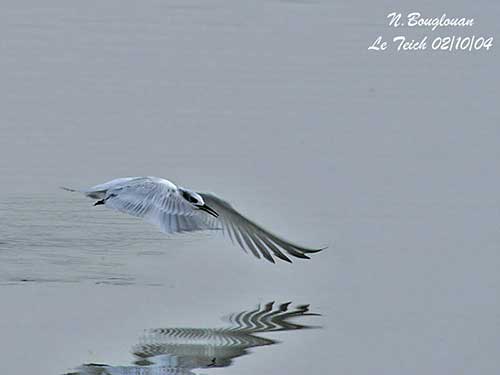
Fr: Sterne caugek
Ang: Sandwich Tern
All: Brandseeschwalbe-sandvicensis
Esp: Charrán Patinegro
Ita: Beccapesci
Nd: Grote Stern
Sd: kentsk tärna
Photographers:
John Anderson
John Anderson Photo Galleries
Nicole Bouglouan
Photographic ramble & My pictures on IBC
Text by Nicole Bouglouan
Sources:
HANDBOOK OF THE BIRDS OF THE WORLD Vol 3 by Josep del Hoyo-Andrew Elliott-Jordi Sargatal - Lynx Edicions - ISBN: 8487334202
THE HANDBOOK OF BIRD IDENTIFICATION FOR EUROPE AND THE WESTERN PALEARCTIC by Mark Beaman, Steve Madge - C. Helm - ISBN: 0713639601
ENCYCLOPEDIE DES OISEAUX DE FRANCE ET D’EUROPE – de Peter Hayman et Rob Hume - Flammarion – ISBN : 2082009920
THE COMPLETE BOOK OF BRITISH BIRDS – Written by “Royal Society for the Protection of Birds” experts - Préface de Magnus Magnusson - Michael Cady- Rob Hume Editors - ISBN: 0749509112
BIRDS OF THE MIDDLE EAST by R.F. Porter, S. Christensen, P Schiermacker-Ansen C.Helm - ISBN: 0713670169
BIRDS OF AFRICA SOUTH OF THE SAHARA by Ian Sinclair and Peter Ryan - Princeton University Press Princeton and Oxford - ISBN: 0691118159
Animal Diversity Web (University of Michigan Museum of Zoology)
Wikipedia, the free encyclopaedia
What Bird-The ultimate Bird Guide (Mitchell Waite)
Studies of breeding Sandwich Terns
Sandwich Tern Sterna sandvicensis (breeding)
Sandwich Tern
Thalasseus sandvicensis
Charadriiformes Order – Laridae Family
INTRODUCTION:
The Sandwich Tern is a slender, medium-sized tern with a long black bill, a unique feature among the « crested « terns.
This species is usually considered a full species and is found in the Old World. It was formerly associated to the Cabot’s Tern (T. acuflavidus) from the New World, and especially Central and South America.
The Sandwich Tern is named after the town of Sandwich in England, where this species was discovered. It was described in 1787 by the ornithologist John Latham, and included in the genus Sterna. It was recently moved to the genus Thalasseus.
The Sandwich Tern nests in colonies on the ground, on coasts, sand dunes and flat islands. It migrates S by following the coasts, and winters on sandy and rocky beach fronts.
This species is vulnerable to human disturbance on beaches near the breeding colonies. It is also threatened by habitat loss in the breeding range, and pollutants. But it is currently not globally threatened.

DESCRIPTION OF THE BIRD:
Biometrics:
Length: 35-45 cm
Wingspan: 86-105 cm
Weight: 130-285 g
The Sandwich Tern adult in breeding plumage has pale grey back and upperwing, whereas rump and forked tail are white. The underparts are white, often with weak pink tinge. The primaries show white inner webs and silvery outer webs. The wings are long and pointed.
On the head, the crown is black with shaggy crest. Head sides, chin and throat are white.
The long, slender bill is black with reduced yellow tip. The eyes are blackish. Legs and webbed feet are black.
Male and female are similar.
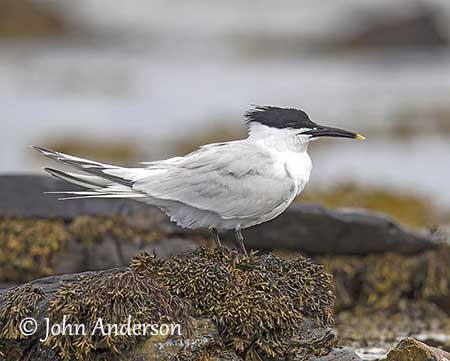

The juvenile has fine black-and-white scaling on the upperparts, almost lost in autumn, and a dark tail band. The black bill is shorter. The head pattern is less uniformly black, often with spotted forecrown.
The first winter resembles non-breeding adult, but some markings may remain on tertials to the first spring.
The first summer resembles adult non-breeding.
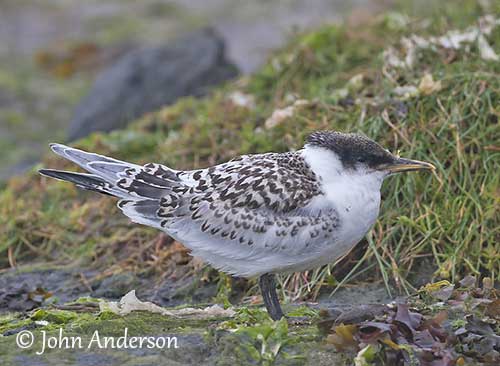
RANGE:
The Sandwich Tern breeds in Europe along the coasts, E to the Caspian Sea. It winters on S Europe coasts, from Caspian, Mediterranean and Black Seas to W and S Africa coasts, Red Sea and Arabian Peninsula. Small but increasing populations winter from S Red Sea to NW India and Sri Lanka.
HABITAT:
The Sandwich Tern breeds on low-lying inshore islands, on undisturbed beaches without vegetation, or on gravelly, muddy or bare substrate.
During winter, it frequents sandy coastal bays, rocky beach fronts, estuaries and harbours.
CALLS AND SONGS: SOUNDS BY XENO-CANTO
The Sandwich Tern gives deep, ringing, far-carrying “kier-ink” or “kirrick”. The rhythm of this quick, double, almost triple call is very distinctive. It also gives a short “kik” or “krik krik”.
The juvenile utters a plaintive, high-pitched, penetrating “swee-swee-swee” when it is accompanied by the adults.
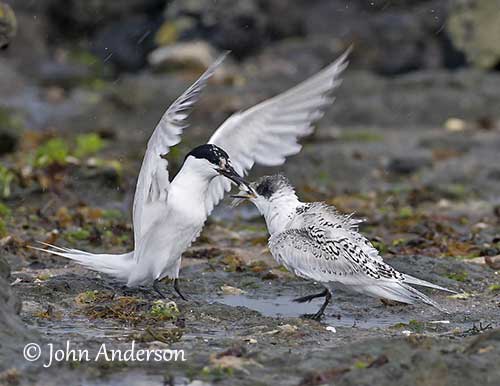
BEHAVIOUR IN THE WILD:
The Sandwich Tern feeds primarily on fish such as sand eels and sardines, and occasionally small shrimps. It also takes marine worms in mudflats, and catches the chicks of shorebirds such as the Pied Avocet in E Europe.
It forages actively by diving in from height (up to 10 metres) with a loud splash. It plunges head first into the water after a short hovering flight. Once the prey is caught, the bird emerges quickly while holding the prey in the bill. It may also catch insects in flight.
The Sandwich Tern may defend its feeding territories along the shores. The feeding areas are sometimes far from the colonies, between 10-15 and 70 kilometres, depending on range and habitat.
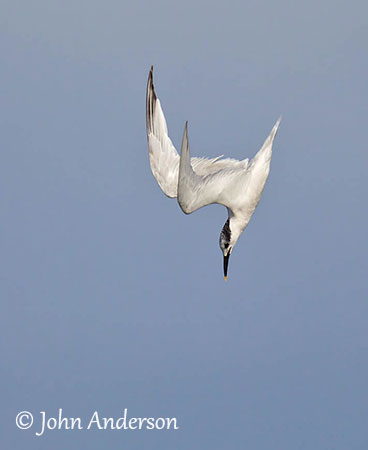

The Sandwich Tern is colonial-nester and forms dense colonies with nests close to each other, up to 5-7 nests/m², sometimes up to 9 nests. The courtship displays start with aerial chases above the colony, a high spiraling flight with long, descending glides.
Some displays take place on the ground. Both mates point their bills upwards while the wings are drooped. They turn their heads from side to side. The male feeds the female by giving her small fish that helps to form the large eggs. During the displays, the black crest is usually raised. They are monogamous.



The Sandwich Tern is migratory and moves S along the W coast of Africa to winter in tropics. The adults move usually further S than the young birds. The S migration starts in mid-September. A few birds remain in Europe. The flocks are often noisy, and their calls are heard before the birds are seen. They are unpredictable birds, quick to take alarm and easily disturbed by approaching intruders.
The Sandwich Tern performs powerful, direct flight, usually strong and graceful with the wings held slightly crooked.
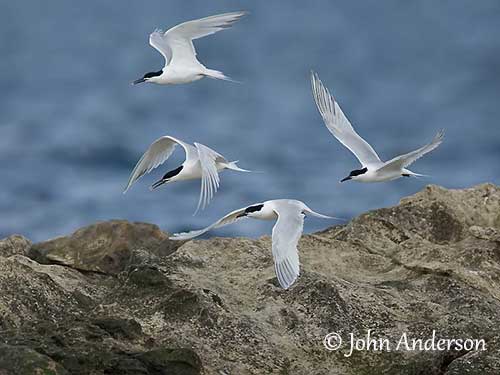

REPRODUCTION OF THIS SPECIES:
The breeding season takes place in May-June. The Sandwich Tern nests in dense colonies, often next to other species, and especially the Black-headed Gull (C. ridibundus). The colonies are often established on open beaches and low, flat, sandy islands close to the shores.
The nest is a shallow depression on the ground, excavated by both mates with some ritual behavior. The scrape is made by planting the breast on the sand while pushing away the sand behind with the feet. The nest is lined with shell, vegetation and droppings throughout the nesting period.
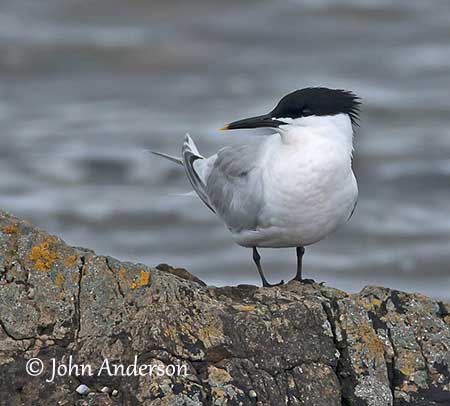
The female lays 1-2 whitish eggs with black markings. Both adults share the incubation during 25 days. At hatching, the chicks have whitish/buff down with some black speckles. The young may form crèches, accompanied by some adults. They fledge about 28-35 days after hatching, and still depend on parents until the first winter.
PROTECTION / THREATS / STATUS:
The Sandwich Tern is vulnerable to human disturbance near the breeding colonies, especially on the beaches. It is threatened by habitat loss or degradation of breeding habitats by inundations and erosion, and pollutants in marine fish. This species is hunted in W Africa during the winter.
The global population is estimated at least at 40,000 pairs, but it is probably larger. The population trend is fluctuating, with stable, increasing or decreasing numbers according to the range.
The Sandwich Tern is currently evaluated as Least Concern.
